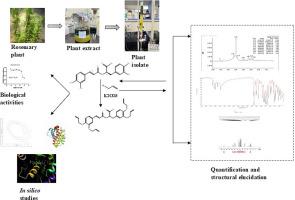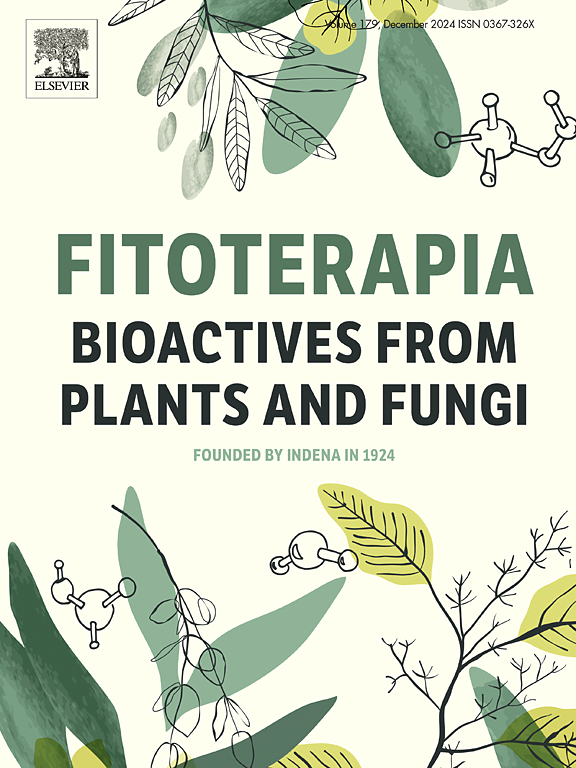Experimental and computational approach to develop Rosmarinic acid against insulin resistance in the treatment of diabetes mellitus via PPAR-γ agonism
IF 2.6
3区 医学
Q3 CHEMISTRY, MEDICINAL
引用次数: 0
Abstract
From past to the present, plants and trees have benefited humans in many ways. As technology advanced the biological properties of plants are much more explored especially by the pharma industry. Rosemary plant has gained attention as a phytoconstituent-rich herb that may help to manage diabetes mellitus (DM), however, exact mechanism of action is still unknown. Rosmarinic acid (RA), is a one of the important bioactive compounds found in rosemary. In this study, we have investigated RA and we synthesized its alkylated derivative (RAD) by blocking the free hydroxyl groups as a probe to investigate. RA was extracted, isolated, purified, and structurally characterized by IR, 1D & 2D NMR, DEPT 135°, LC-MS/MS, similarly, RAD. In silico molecular docking studies indicated that both RA and RAD bind to PPAR-γ (Peroxisome Proliferator-Activated Receptor) protein, however, RA showed superior binding affinity with free hydroxyl groups. MD simulation results demonstrated stability in terms of RMSD, RMSF and Protein-ligand interaction profiles. RA demonstrated promising antidiabetic activities via PPAR-γ agonism such as glucose uptake in cells (65 % for RA vs. 51 % for RAD) and enhanced lipid-lowering effects (71 % for RA vs. 48 % for RAD). The EC50 values of on target protein binding assays (via TR-FRET) also showed better results for RA (7.78 μM vs. 37.84 μM for RAD). The GLUT-4 expression assay demonstrated that anti-diabetic potential of RA in L6 cells, Standard pioglitazone and RA showed better GLUT-4 expression of 67.87 % & 74.85 % compared to 51.83 % by RAD. The in silico studies have validated the biological studies. Altogether, we strategically isolated and elucidated mechanism for RA as a potential therapeutic in the treatment of DM via PPAR-γ agonism.

通过PPAR-γ激动作用开发迷迭香酸治疗糖尿病胰岛素抵抗的实验和计算方法
从过去到现在,植物和树木在许多方面给人类带来了好处。随着技术的进步,植物的生物学特性得到了越来越多的探索,特别是制药行业。迷迭香作为一种富含植物成分的草药,可能有助于控制糖尿病(DM),但其确切的作用机制尚不清楚。迷迭香酸(rorosemary acid, RA)是迷迭香中重要的生物活性物质之一。在本研究中,我们对RA进行了研究,并通过阻断游离羟基作为探针合成了RA的烷基化衍生物(RAD)。RA被提取、分离、纯化,并通过IR、1D & 2D NMR、DEPT 135°、LC-MS/MS以及类似的RAD进行了结构表征。在硅分子对接研究中,RA和RAD都与PPAR-γ(过氧化物酶体增殖物激活受体)蛋白结合,但RA与游离羟基表现出更强的结合亲和力。MD模拟结果显示RMSD, RMSF和蛋白质-配体相互作用谱方面的稳定性。RA通过PPAR-γ激动作用表现出有希望的抗糖尿病活性,如细胞中的葡萄糖摄取(RA为65%,RAD为51%)和增强的降脂作用(RA为71%,RAD为48%)。靶蛋白结合试验的EC50值(通过TR-FRET)也显示RA的结果更好(7.78 μM vs. 37.84 μM RAD)。glt -4表达试验表明,RA在L6细胞中具有抗糖尿病潜能,标准吡格列酮和RA的glt -4表达量分别为67.87%和74.85%,而RAD的glt -4表达量分别为51.83%。总之,我们战略性地分离并阐明了RA通过PPAR-γ激动作用治疗DM的潜在治疗机制。
本文章由计算机程序翻译,如有差异,请以英文原文为准。
求助全文
约1分钟内获得全文
求助全文
来源期刊

Fitoterapia
医学-药学
CiteScore
5.80
自引率
2.90%
发文量
198
审稿时长
1.5 months
期刊介绍:
Fitoterapia is a Journal dedicated to medicinal plants and to bioactive natural products of plant origin. It publishes original contributions in seven major areas:
1. Characterization of active ingredients of medicinal plants
2. Development of standardization method for bioactive plant extracts and natural products
3. Identification of bioactivity in plant extracts
4. Identification of targets and mechanism of activity of plant extracts
5. Production and genomic characterization of medicinal plants biomass
6. Chemistry and biochemistry of bioactive natural products of plant origin
7. Critical reviews of the historical, clinical and legal status of medicinal plants, and accounts on topical issues.
 求助内容:
求助内容: 应助结果提醒方式:
应助结果提醒方式:


